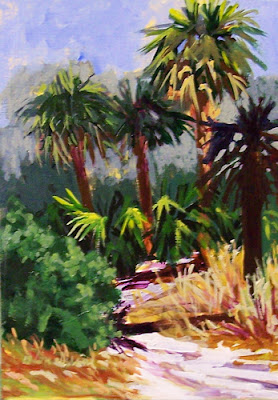 Evinston
Evinston Florida
12x16 inches
oil on canvas
Not much time to paint in the last few days
because of my trip, I'll
finish this when I return. I'll show it to you all again when it is done.
Painters Journal
March is an exciting month for me. I will be surrounded by nature on my travels. I leave tomorrow for Wekiva Springs State Park to rough it for 5 days in a cabin with three other painters, no air conditioners, and a bathroom separate from the cabins. It' been a long time since I did that sort of thing. It will be an adventure. After Wekiva, I will take a fast run to Alabama to pick up my daughter and return just in time to head for the Florida Trail Association Annual Conference in Umatilla Florida. I will be doing painting demos there and enjoying all of the nature and hiking related activities for two days. I am very excited about that. There i s going to be an early morning hike on Saturday which I am looking forward to.
Posts will be few and far between for the next two weeks but I will do my best. If by some miracle, the parks have wireless Internet access, I will be posting. I truly doubt that they do.
Painters Tip
Framing For Paint Outs
I do few big paint outs each year here in Florida, Georgia or Alabama. I often get email from artists who don't know what to do about framing their work for paint outs. Many people don't realize that we must have all of our framing supplies, frames and equipment with us for these paint outs. Yes, we have to frame wet paintings, often from the trunk of our cars. The good promoters give us a frame shack to do our framing out of bad weather and such.
What I do to save time and be as efficient as possible, is to pre-wire my frames in the studio. I bring along the canvas holders with the screws and the point gun with me for panels, but the frames already have the hardware installed before I go. Most of my frames are wired for horizontal orientation but I always bring a couple for vertical paintings too. I bring the screwdriver to change them if I need to. I use a flexible point gun, which means that I can bend the points back to insert the panel or canvas. I put a blank panel in the frame and shoot the points in at the studio, then carefully bend the points back out to take out the panel. When the painting is done, I just drop it in the frame, bend the points back in place and hang it up to sell. It saves me a lot of time, when I really need to be painting rather than framing.
I always bring retouch varnish with me to spray the paintings before putting them in the frames. it is not a permanent varnish but will give the painting some gloss and protect it until the owner can later have it varnished when it is completely dry. With acrylic, I put a coat of gloss glazing medium over the surface and then frame.
Lastly, I bring labels with me that say either oil painting or acrylic and my number and web site. I order them online.
Never let a painting get away from you without some kind of contact information on the back. Remember, most art buyers collect more than one painting from an artist.



























